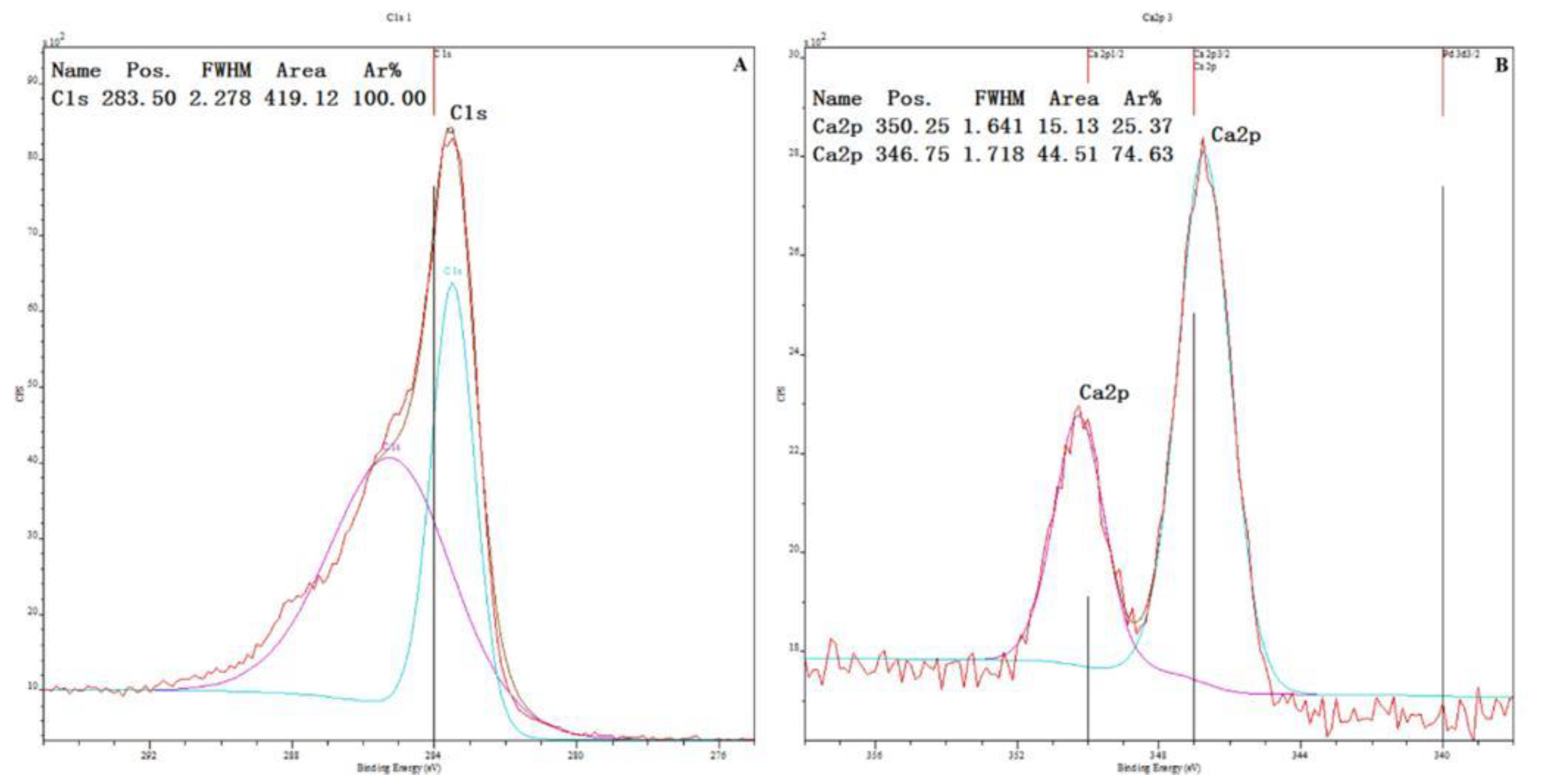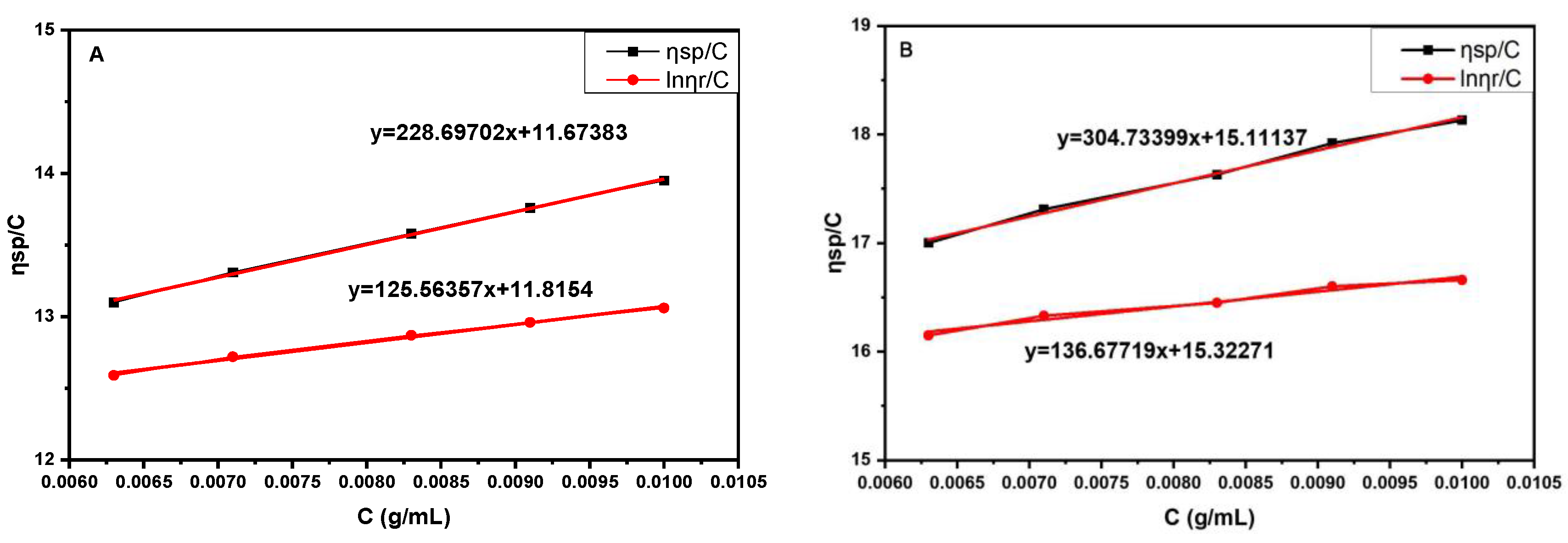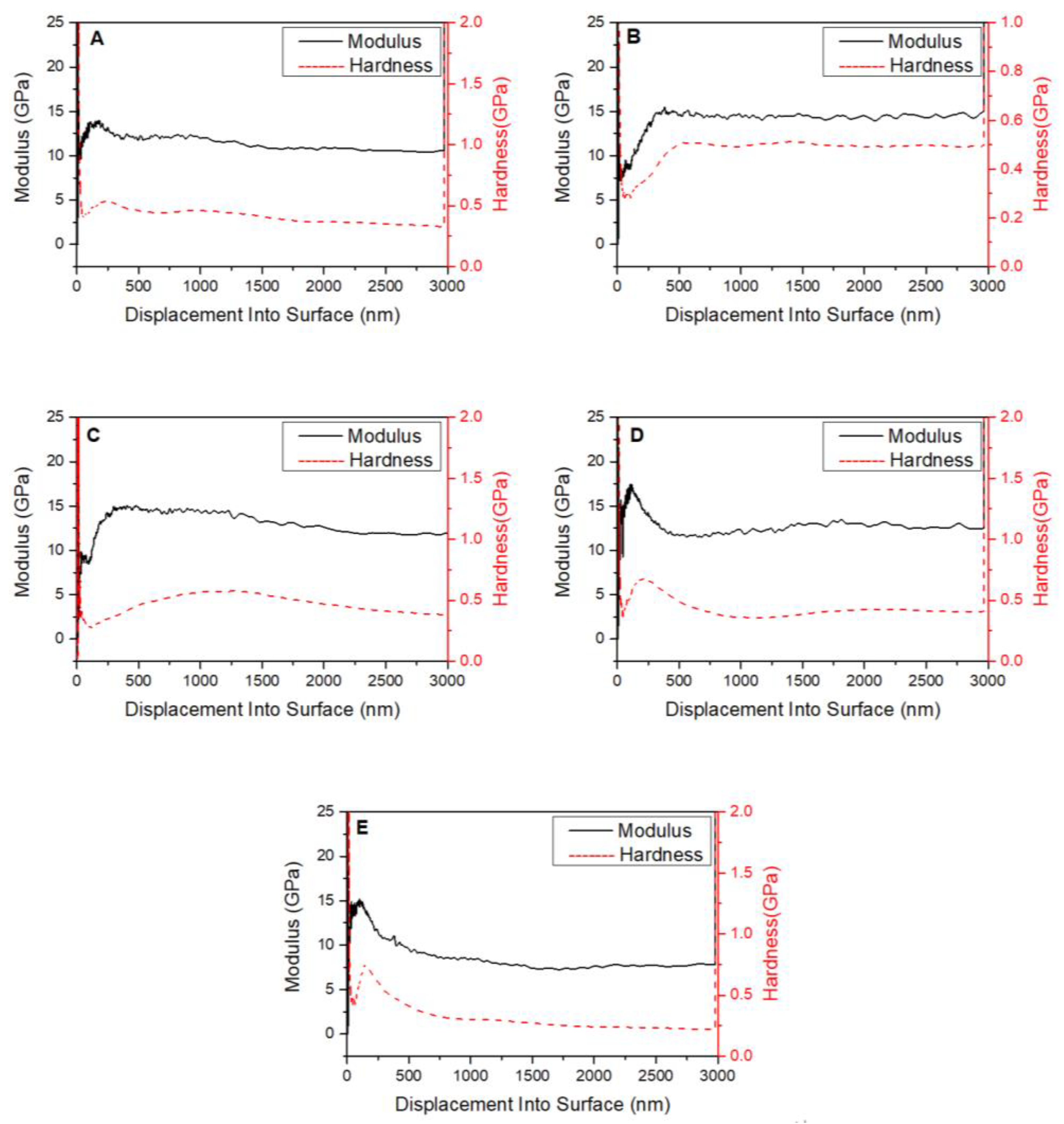Preparation and Characterization of a Polyetherketoneketone/Hydroxyapatite Hybrid for Dental Applications
Abstract
:1. Introduction
2. Materials and Methods
2.1. Materials
2.2. Synthesis of PEKK/HA Composites
2.3. Characterization
2.3.1. Back Reflection Infrared Spectroscopy
2.3.2. X-ray Photoelectron Spectroscopy
2.3.3. Scanning Electron Microscopy and Transmission Electron Microscopy
2.3.4. Molecular Weight
2.3.5. Mechanical Analysis
3. Results
3.1. Back Reflection Infrared Spectroscopy
3.2. X-ray Photoelectron Spectroscopy
3.3. SEM, TEM and EDS Mapping
3.4. Effect of HA on the Molecular Weight of PEKK
3.5. Mechanical Properties of the Composite
4. Discussion
5. Conclusions
Author Contributions
Funding
Institutional Review Board Statement
Informed Consent Statement
Conflicts of Interest
References
- Gama, L.T.; Bezerra, A.P.; Schimmel, M.; Rodrigues Garcia, R.C.M.; de Luca Canto, G.; Goncalves, T.M.S. Clinical performance of polymer frameworks in dental prostheses: A systematic review. J. Prosthet. Dent. 2022, 3, 1–12. [Google Scholar] [CrossRef] [PubMed]
- Taymour, N.; Fahmy, A.E.; Gepreel, M.A.H.; Kandil, S.; El-Fattah, A.A. Improved Mechanical Properties and Bioactivity of Silicate Based Bioceramics Reinforced Poly(ether-ether-ketone) Nanocomposites for Prosthetic Dental Implantology. Polymers 2022, 14, 1632. [Google Scholar] [CrossRef]
- Botelho, J.; Machado, V.; Proenca, L.; Oliveira, M.J.; Cavacas, M.A.; Amaro, L.; Aguas, A.; Mendes, J.J. Perceived xerostomia, stress and periodontal status impact on elderly oral health-related quality of life: Findings from a cross-sectional survey. BMC Oral Health 2020, 20, 199. [Google Scholar] [CrossRef] [PubMed]
- Poggio, C.E.; Ercoli, C.; Rispoli, L.; Maiorana, C.; Esposito, M. Metal-free materials for fixed prosthodontic restorations. Cochrane Database Syst. Rev. 2017, 12, CD009606. [Google Scholar] [CrossRef] [PubMed]
- Yu, S.J.; Chen, P.; Zhu, G.X. Relationship between implantation of missing anterior teeth and oral health-related quality of life. Qual. Life Res. 2013, 22, 1613–1620. [Google Scholar] [CrossRef]
- Duraccio, D.; Mussano, F.; Faga, M.G. Biomaterials for dental implants: Current and future trends. J. Mater. Sci. 2015, 50, 4779–4812. [Google Scholar] [CrossRef]
- Wang, Y.J.; Jin, Y.B.; Chen, Y.Y.; Han, T.L.; Chen, Y.H.; Wang, C. A preliminary study on surface bioactivation of polyaryletherketone by UV-grafting with PolyNaSS: Influence on osteogenic and antibacterial activities. J. Biomater. Sci. Polym. Ed. 2022, 33, 1845–1865. [Google Scholar] [CrossRef]
- Aparicio, C.; Padrós, A.; Gil, F.J. In vivo evaluation of micro-rough and bioactive titanium dental implants using histometry and pull-out tests. J. Mech. Behav. Biomed. Mater. 2011, 4, 1672–1682. [Google Scholar] [CrossRef]
- Krautwald, L.; Smeets, R.; Stolzer, C.; Rutkowski, R.; Guo, L.; Reitmeier, A.; Gosau, M.; Henningsen, A. Osseointegration of Zirconia Implants after UV-Light or Cold Atmospheric Plasma Surface Treatment In Vivo. Materials 2022, 15, 496. [Google Scholar] [CrossRef]
- Mihatovic, I.; Golubovic, V.; Becker, J.; Schwarz, F. Bone tissue response to experimental zirconia implants. Clin. Oral Investig. 2017, 21, 523–532. [Google Scholar] [CrossRef]
- Hanawa, T. Zirconia versus titanium in dentistry: A review. Dent. Mater. J. 2020, 39, 24–36. [Google Scholar] [CrossRef] [Green Version]
- Roehling, S.; Schlegel, K.; Woelfler, H.; Gahlert, M. Zirconia compared to titanium dental implants in preclinical studies—A systematic review and meta-analysis. Clin. Oral Implan. Res. 2019, 30, 365–395. [Google Scholar] [CrossRef] [PubMed]
- Ban, S. Classification and Properties of Dental Zirconia as Implant Fixtures and Superstructures. Materials 2021, 14, 4879. [Google Scholar] [CrossRef] [PubMed]
- Hallmann, L.; Mehl, A.; Ulmer, P.; Reusser, E.; Stadler, J.; Zenobi, R.; Stawarczyk, B.; Ozcan, M.; Hmmerle, C.H.F. The influence of grain size on low-temperature degradation of dental zirconia. J. Biomed. Mater. Res. Part B 2020, 100B, 447–456. [Google Scholar] [CrossRef] [PubMed]
- Fratucelli, E.D.O.; Candido, L.M.; Pinelli, L.A.P. Surface properties and flexural strength of a monolithic zirconia submitted to grinding and regenerative heat treatment. Int. J. Appl. Ceram. Tec. 2020, 18, 525–531. [Google Scholar] [CrossRef]
- Elnayef, B.; Lázaro, A.; Suárez-López Del Amo, F.; Galindo-Moreno, P.; Wang, H.; Gargallo-Albiol, J.; Hernández-Alfaro, F. Zirconia Implants as an Alternative to Titanium: A Systematic Review and Meta-Analysis. Int. J. Oral Max. Impl. 2017, 32, e125–e134. [Google Scholar] [CrossRef] [Green Version]
- Chevalier, J.; Gremillard, L. Ceramics for medical applications: A picture for the next 20 years. J. Eur. Ceram. Soc. 2009, 29, 1245–1255. [Google Scholar] [CrossRef]
- Chevalier, J. What future for zirconia as a biomaterial? Biomaterials 2006, 27, 535–543. [Google Scholar] [CrossRef]
- Ozkurt, Z.; Kazazoglu, E. Clinical Success of Zirconia in Dental Applications. J. Prosthodont. 2010, 19, 64–68. [Google Scholar] [CrossRef]
- Kihara, H.; Hatakeyama, W.; Kondo, H.; Yamamori, T.; Baba, K. Current complications and issues of implant superstructure. J. Oral Sci. 2022, 64, 257–262. [Google Scholar] [CrossRef]
- Suphangul, S.; Rokaya, D.; Kanchanasobhana, C.; Rungsiyakull, P.; Chaijareenont, P. PEEK Biomaterial in Long-Term Provisional Implant Restorations: A Review. J. Funct. Biomater. 2022, 13, 33. [Google Scholar] [CrossRef] [PubMed]
- Milavec, H.; Kellner, C.; Ravikumar, N.; Albers, C.; Lerch, T.; Hoppe, S.; Deml, M.; Bigdon, S.; Kumar, N.; Benneker, L. First Clinical Experience with a Carbon Fibre Reinforced PEEK Composite Plating System for Anterior Cervical Discectomy and Fusion. J. Funct. Biomater. 2019, 10, 29. [Google Scholar] [CrossRef] [PubMed] [Green Version]
- Wang, M.; Bhardwaj, G.; Webster, T. Antibacterial properties of PEKK for orthopedic applications. Int. J. Nanomed. 2017, 12, 6471–6476. [Google Scholar] [CrossRef] [PubMed] [Green Version]
- Yuan, B.; Cheng, Q.; Zhao, R.; Zhu, X.; Yang, X.; Yang, X.; Zhang, K.; Song, Y.; Zhang, X. Comparison of osteointegration property between PEKK and PEEK: Effects of surface structure and chemistry. Biomaterials 2018, 170, 116–126. [Google Scholar] [CrossRef] [PubMed]
- Han, X.; Rodríguez-Lozano, F.; Luong-Van, E.K.; Tong, C.; Rosa, V. Graphene for the development of the next-generation of biocomposites for dental and medical applications. Dent. Mater. 2017, 33, 765. [Google Scholar]
- Asadullah, S.; Wu, H.; Mei, S.Q.; Wang, D.Q.; Pan, Y.K.; Wang, D.L.; Zhao, J.; Wei, J. Preparation, characterization, in vitro bioactivity and rBMSCs responses to tantalum pentoxide/polyimide biocomposites for dental and orthopedic implants. Compos. Part B Eng. 2019, 177, 107433. [Google Scholar] [CrossRef]
- Ma, Y.; Xu, G.S. Methods for preparation of Organic/Inorganic Nanocomposites. Chem. Eng. Equip. 2008, 3, 62–64. [Google Scholar]
- Hu, X.; Mei, S.; Wang, F.; Tang, S.; Xie, D.; Ding, C.; Du, W.; Zhao, J.; Yang, L.; Wu, Z. A microporous surface containing Si3N4/Ta microparticles of PEKK exhibits both antibacterial and osteogenic activity for inducing cellular response and improving osseointegration. Bioact. Mater. 2021, 6, 3136–3149. [Google Scholar] [CrossRef]
- Khoury, J.; Maxwell, M.; Cherian, R.E.; Bachand, J.; Kurz, A.C.; Walsh, M.; Assad, M.; Svrluga, R.C. Enhanced bioactivity and osseointegration of PEEK with accelerated neutral atom beam technology. J. Biomed. Mater. Res. B Appl. Biomater. 2017, 105, 531–543. [Google Scholar] [CrossRef]
- Converse, G.L.; Conrad, T.L.; Merrill, C.H.; Roeder, R.K. Hydroxyapatite whisker-reinforced polyetherketoneketone bone ingrowth scaffolds. Acta Biomater. 2010, 6, 856–863. [Google Scholar] [CrossRef]
- Jiang, J.W.; Ding, N.W.; Cai, M.Z. Synthesis and properties of copolymers of poly(ether ketone ketone) and poly(ether amide ether amide ether ketone ketone). Polym. Int. 2011, 60, 240–246. [Google Scholar] [CrossRef]
- Huang, B.; Zhu, M.H.; Cai, M.Z. Synthesis and Characterization of Poly(ether amide ether ketone)/Poly(ether ketone ketone) Copolymers. J. Appl. Polym. Sci. 2011, 119, 647–653. [Google Scholar] [CrossRef]
- Zhu, M.H.; Sun, Y.F.; Cai, M.Z. Synthesis and Characterization of Copolymers of Poly(aryl ether ketone amide) and Poly(aryl ether ketone ketone). High Perform. Polym. 2010, 22, 763–778. [Google Scholar]
- Li, C.; Bao, L.; Wu, J.; Dong, M.; Zhang, X. Synthesis and Biomechanical Compatibility of High Loading Hydroxyapatite and Poly (ether ketone ketone) Composite. J. Mater. Sci. Eng. 2019, 37, 205–209. [Google Scholar]
- Yang, X.; Wu, J.; Li, C.; Bao, L.; Ma, Z.; Xuan, Z.; Zhang, X.; Zhang, X. Mechanical Property and Biological Activity of Polyetherketoneketone/Hydroxyapatite Composite Implants. J. Fun. Polym. 2019, 32, 7. [Google Scholar]
- Tertuliano, O.A.; Greer, J.R. The nanocomposite nature of bone drives its strength and damage resistance. Nat. Mater. 2016, 15, 1195. [Google Scholar] [CrossRef] [PubMed] [Green Version]
- Xu, X.Y.; He, L.B.; Zhu, B.G.; Li, J.Y.; Li, J.S. Advances in polymeric materials for dental applications. Polym. Chem. 2017, 8, 807–823. [Google Scholar] [CrossRef]
- Schwitalla, A.; Muller, W.D. PEEK Dental Implants: A Review of the Literature. J. Oral. Implant. 2013, 39, 743–749. [Google Scholar] [CrossRef]
- Yurttutan, M.E.; Keskin, A. Evaluation of the effects of different sand particles that used in dental implant roughened for osseointegration. BMC Oral Health 2018, 18, 47. [Google Scholar] [CrossRef] [Green Version]
- Najeeb, S.; Zafar, M.S.; Khurshid, Z.; Siddiqui, F. Applications of polyetheretherketone(PEEK) in oral implantology and prosthodontics. J. Prosthodont. Res. 2016, 60, 12–19. [Google Scholar] [CrossRef]








| Test | Average Indentation Modulus (GPa) | Average Hardness (GPa) |
|---|---|---|
| A | 11.5 | 0.42 |
| B | 14.5 | 0.5 |
| C | 13.8 | 0.51 |
| D | 12.4 | 0.4 |
| E | 8.1 | 0.29 |
| Mean | 12.1 | 0.42 |
| Std. Dev. | 2.5 | 0.09 |
| % COV | 20.61 | 20.99 |
Publisher’s Note: MDPI stays neutral with regard to jurisdictional claims in published maps and institutional affiliations. |
© 2022 by the authors. Licensee MDPI, Basel, Switzerland. This article is an open access article distributed under the terms and conditions of the Creative Commons Attribution (CC BY) license (https://creativecommons.org/licenses/by/4.0/).
Share and Cite
Lu, W.; Li, C.; Wu, J.; Ma, Z.; Zhang, Y.; Xin, T.; Liu, X.; Chen, S. Preparation and Characterization of a Polyetherketoneketone/Hydroxyapatite Hybrid for Dental Applications. J. Funct. Biomater. 2022, 13, 220. https://doi.org/10.3390/jfb13040220
Lu W, Li C, Wu J, Ma Z, Zhang Y, Xin T, Liu X, Chen S. Preparation and Characterization of a Polyetherketoneketone/Hydroxyapatite Hybrid for Dental Applications. Journal of Functional Biomaterials. 2022; 13(4):220. https://doi.org/10.3390/jfb13040220
Chicago/Turabian StyleLu, Wenhsuan, Conglei Li, Jian Wu, Zhongshi Ma, Yadong Zhang, Tianyi Xin, Xiaomo Liu, and Si Chen. 2022. "Preparation and Characterization of a Polyetherketoneketone/Hydroxyapatite Hybrid for Dental Applications" Journal of Functional Biomaterials 13, no. 4: 220. https://doi.org/10.3390/jfb13040220
APA StyleLu, W., Li, C., Wu, J., Ma, Z., Zhang, Y., Xin, T., Liu, X., & Chen, S. (2022). Preparation and Characterization of a Polyetherketoneketone/Hydroxyapatite Hybrid for Dental Applications. Journal of Functional Biomaterials, 13(4), 220. https://doi.org/10.3390/jfb13040220






